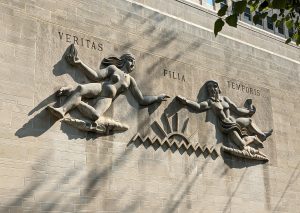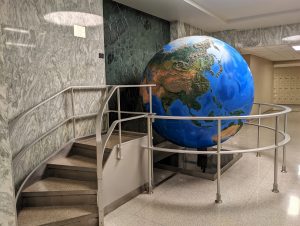7 The (Not-So) Hidden Joys of Ballantine Hall
Ballantine Hall is not one of the most exciting buildings on the Bloomington campus. Built in 1959 to help accommodate an influx of students to Indiana University following World War II, this enormous building is largely free of decorative elements. Because of this, Ballantine Hall might seem like an odd choice to include in a tour of the campus’s quirkier features. However, it is that very lack of interesting features that make Ballantine’s special touches stand out.
Finding Truth at Ballantine Hall

Walking around the outside of Ballantine Hall, the aspect of the building you will likely notice first is its vast expanse of flat, plain grayness. But keep walking until you reach the northwest side of the building and look up! You will see Veritas Filia Temporis (Truth Is the Daughter of Time), a large and beautiful decorative panel depicting Father Time and his daughter Truth. If this carving looks familiar, that may be because it was designed by Robert Laurent, an IU Fine Arts faculty member who also designed the sculpture inside the Showalter Fountain, The Birth of Venus.1
Watching the world turn

Walk inside Ballantine Hall’s northern entrance and you will encounter another delightful feature: a geophysical globe six feet in diameter that performs a complete rotation every three minutes.2 The names of the features on the globe are hand-lettered, and the globe can be adjusted to reflect changes in national boundaries.3
The globe has been around since 1961 and still looks great for its age. The mechanism that keeps this world turning, however, has gotten pretty creaky over the years. To enjoy the natural creakiness of the Ballantine Hall globe, you’ll have to visit in person. To see the globe in action accompanied by some jaunty music, you can watch the video below:
